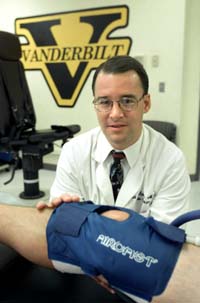
Dr. Kurt Spindler is studying how ice affects healing deep inside joints. (photo by Dana Johnson)
Study thaws mystery of ice's healing properties
When an ankle is sprained or a knee twisted, ice is applied.
Everyone knows that. The practice is so common and ingrained in first-aid lore that, until now, no one has bothered to seriously question whether the practice does indeed affect healing. Does the ice really help bone and joint injuries or is it just a superficial remedy?
Sports medicine researchers at VUMC have asked the questions, and for the first time they have solid scientific proof about the effectiveness deep inside the knee of ice applied topically.
"We have proven that not only does the ice cool the superficial aspect of the joint, we now know that the ice actually cools the inner lining of the knee, the synovium," said Dr. Kurt P. Spindler, associate professor of Orthopaedics and Rehabilitation and director of Vanderbilt Sports Medicine.
"And we know that the synovium is the active component in the knee that produces all the inflammation. It produces chemical mediators, cytokines that can produce a lot of pain and inflammation. No one has ever shown until now that ice applied externally actually cools the knee down internally,"
"Hundreds of thousands of routine arthroscopies are done each year and this information will help all of us reduce the trauma on the synovium, thereby helping the patient heal quicker and with better results."
Spindler supervised two studies on cooling the knee, which produced these new results.
"In one study, we had tiny probes, that we inserted during an arthroscopy surgery to repair a knee. We applied ice on the knee and measured temperature continuously for two hours."
Spindler said besides lowering the temperature in superficial locations in the knee, the research looked at the effect on the synovium above the knee cap and on the inside of the knee cap.
"We measured both of these sites and we found the same thing. The drops in temperature aren't as great, but we still were able to actually lower the temperature about six degrees Celsius in the synovium, proving that we truly are getting a profound biologic affect at the level of the synovium.
"Now we have to rethink our procedures about how ice helps people after a knee injury or after a knee surgery, because it clearly is affecting the synovium and it clearly is affecting the articular cartilage."
Spindler says he believes pressure on the affected area also may help alleviate trauma and aid healing and that ice can also affect bleeding. He will be investigating those issues in future studies.
Spindler also plans to measure some of the chemical mediators (cytokines) that are in the synovial fluid after surgery to see if different mediators develop because of the change in temperature.
"I know from doing tissue culture experiments that if you change a degree or two Celsius in the tissue culture, you get profound biological affects as far as significant differences in some of their growth rates and some of the proteins they produce. We are showing a six-degree difference in synovium, so I can't imagine it is not going to affect how that synovium reacts to injury. I think it should to have some significant effect."
Spindler says the new research can also help the general public struggling with a knee or other joint injury. He says applying ice and some general compression to the area is a good idea.
"It should not be really tight pressure, just general pressure. Make sure the ice conforms to the surface of the skin. Too much pressure could cause problems.
"Apply the ice and general pressure for about 15-20 minutes, then remove for an equal amount of time, then it could be iced up again."
Spindler says he is thrilled to find a scientific basis for what people have done for many years.
"People have given up using ice in recent years saying even if it works, it's because of the peripheral skin effect that helps with pain control. What we are saying is, 'No, it's more than that. It is actually working where we want it to work, at the deeper level inside the knee, at the synovium, the structure that is so critical in its reaction to trauma and injury.'
"The damage to the synovium determines how fast someone recovers, which translates into how fast someone can get out on an athletic field or how fast someone can walk normally after arthroscopy.
The original idea for this study, Spindler says, came from a Vanderbilt University medical student.
"Hilary Ann Petersen raised the issue. I suggested she follow the scientific method of reviewing the literature on the topic. Then we found that the question had never been adequately addressed before, so we started the study.
"It is just the power of academics. The power of young people asking questions, even though you think they are already answered."













